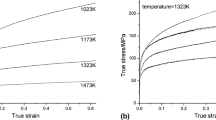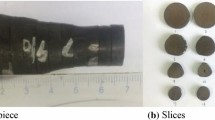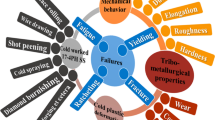Abstract
A three high planetary mill is used to produce bismuth-containing stainless-steel bars with high production efficiency. However, due to the influence of bismuth metal properties, the selection of processing parameters must be optimized to avoid the generation of cracking in the bar core. To solve this contradiction and find a suitable processing zone, the thermal simulation experiment of bismuth-containing stainless-steel material was carried out first to determine the constitutive relationship of the material. Three-roll planetary rolling experiments were carried out to determine the crack-producing region. Based on the Brozzo ductile fracture criterion, the fracture threshold of bismuth-containing austenitic stainless-steel bars in three-roll planetary rolling was determined by the finite element (FE) simulation. Five key process parameters were selected, with five factors and four levels of the orthogonal test designed. Through FE simulations, the possibility of cracking of stainless-steel bars with bismuth austenites in different technologic conditions was judged, and a set of optimal technologic parameters was obtained. Based on range analysis, the influence of various process parameters on bar cracking was discussed. Then, based on the dynamic material model and Murty criterion, the processing map of free-cutting austenitic stainless containing bismuth was established. It was found that the optimum process parameters were consistent with the processable range of the hot-working chart. Finally, the field rolling was carried out with the optimum process parameters, showing that there was no crack in the bar.










Similar content being viewed by others
References
C. Jie, R.Z. Li, C.A. Wang: Food Saf. Qual., 2014, pp. 3553–55.
Y. Takeuchi, R. Takagi, T. Shinoda: Weld. Res. Suppl., 1992, pp. 283–90.
[3]Boris R, Aleksandr G, Aleksandr A: Advanced Manufacturing Technology., 2018, vol.97,pp.3223–3230.
[4]He L, Jie H, Yabao W, Defu, L: Special Casting & Nonferrous Alloys., 2014,vol. 39,pp.171-197.
W.Z. Yin: Adv. Mater. Res., 2013, vol. 712–715(2), pp. 1724–28.
X.K. Wang, J.D. Ye, X. Ma, Q.Q. Tian, X. Li, Y. Bao: Appl. Mech. Mater., 2013, vol. 470, pp. 197–204.
[7]Wu S J, Hwang Y M, Chang M H: Materials Processing Technology.,2002, vol.123(3),pp.336-345.
F.A. Freudenthal: The Inelastic Behavior of Solids, New York, 1950.
[9]M. Cockcroft, D. Latham: The Institute of Metals ., 1968,vol.96 (1),pp. 33–39.
P. Brozzo, B. Deluca, R. Rendina: Proceedings of the 7th biennial Conference of the International Deep Drawing Research Group, 1972.
[11]Carpinteri A, Corrado M, Gong B, Perdonò, Pasquale : International Journal of Fracture., 2018,vol. 211(46),pp. 43-59.
[12]**aoya Y, An HE, Hailong Z, **tao W: Hot Working Technology.,2015,vol.12(8),pp.245-251.
[13]Hao Ma, Wenchen Xu, Bo Cheng **, Shan, Debin Nutt, Steven R:Mechanical Sciences .,2015,vol.100,pp.99-111.
[14]Agmell M, Bushlya V, Laakso S V A, Sampsa: Advanced Manufacturing Technology., 2018,vol. 40(96),pp.2853-2865.
[15]Murty S V S N, Rao B N: Materials Science & Engineering A., 1998,vol. 254(1–2),pp.76-82.
Acknowledgments
The authors acknowledge the financial support from the State Key Laboratory of Materials Processing and Die & Mould Technology, Huazhong University of Science and Technology, through research grant P2020-020. This research was also funded by the State Key Laboratory of Refractories and Metallurgy, Wuhan University of Science and Technology.
Author information
Authors and Affiliations
Corresponding author
Additional information
Publisher's Note
Springer Nature remains neutral with regard to jurisdictional claims in published maps and institutional affiliations.
Manuscript submitted November 26, 2019.
Rights and permissions
About this article
Cite this article
Hu, SD., Jiang, YN., Zhou, C. et al. Prediction and Prevention of Cracks in Free-Cutting Stainless Steel Bar Forming. Metall Mater Trans B 51, 1687–1696 (2020). https://doi.org/10.1007/s11663-020-01843-7
Received:
Published:
Issue Date:
DOI: https://doi.org/10.1007/s11663-020-01843-7




